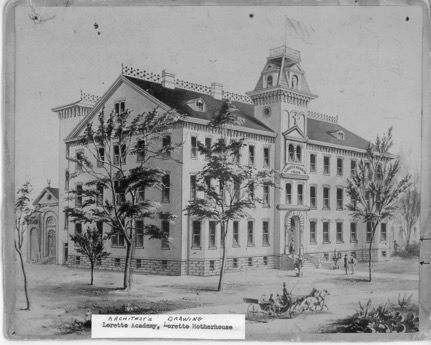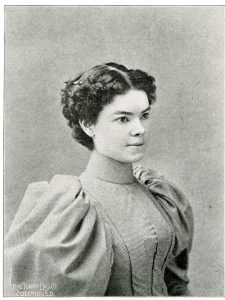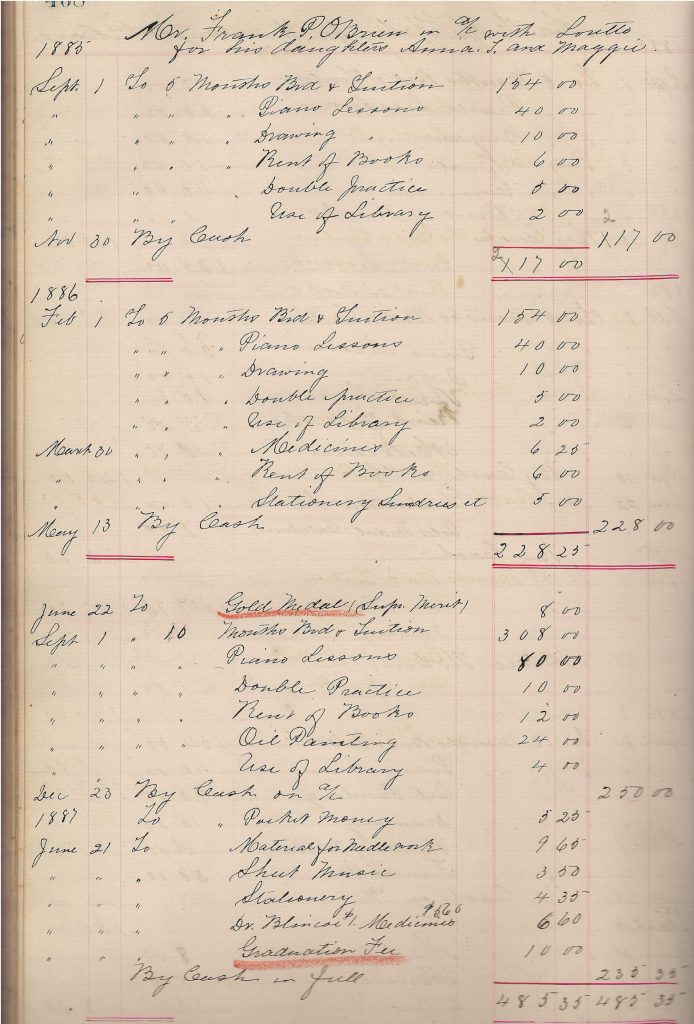LOREtto Teaching: FIDES, MORES, CULTURA
Posted on September 13, 2018, by Eleanor Craig SL

Loretto Academy at Loretto Motherhouse, opened in 1834 in today’s “Rhodes Hall,” steadily pursued its mission of education, through times of financial boom and bust, through the fire of 1858 which destroyed most of the Motherhouse, and despite the turmoil of the Civil War.
For fifty years in the original building the Sisters of Loretto conducted classes for more than 1600 girls and young women. Some students were the privileged daughters of wealthy landowners, public officials, and professional men; most were the daughters of the middle classes; a small number were children of poverty or tragedy, not only educated but entirely raised by the Sisters.
Like girls and young women in academies across the South, Loretto students were encouraged to reach high for learning and for culture, to let themselves be shaped for futures both domestic and public. Take as an example Margaret Ellen O’Brien Davis, Class of 1888. She began her Loretto education in the old building in 1884 and completed it in the new Academy which opened in 1886.

Margaret O’Brien was the third of five daughters of Frank and Indiana O’Brien of Birmingham, Alabama, all of whom attended Loretto Academy at Loretto Kentucky between 1880 and 1898. Margaret was a stand-out among her sisters, precocious, animated and frank. She grew to be a gifted writer: a published poet at age 16, a professional newspaper woman by age 20.
Immediately after graduating from Loretto, Margaret became her father’s partner in editing a Birmingham newspaper, the Age-Herald, to which she also contributed a weekly column.
In 1892 Margaret entered the Loretto novitiate, but became so ill she was forced to return home. She tried again in 1894, receiving the habit and the name Sister Margaret Marie, but again became too ill to continue. Her younger sister Annie was later received into Loretto as Sister Marie Patrice. On the train going to Annie’s reception ceremony in 1897, Margaret met Dr. John Davis, and married him just three months later.
From 1894 to 1898 Margaret participated in the slow demise of her father’s paper and the start of her own magazine of literary works by women. She wrote for other papers too, and published several books. She became known as a crusading journalist and outspoken advocate of women’s rights. She advocated for the formation of a Women’s Press Association, organized the Alabama Chapter of the Association and was elected its Secretary. Then suddenly, Margaret O’Brien Davis died at the age of 28.
A regional editor and literary critic, Thomas Cooper De Leon wrote in The Alkahest “Margaret O’Brien had, in a few short years, set her literary mark upon the literature of her section; and her passing away leaves a blank in the very forefront of the women writers of the South.”
Earlier, a New York City trade journal had recognized Margaret’s reputation as being “Far beyond the confines of Alabama, her work …counted among the brightest women writers of the South.”
Here’s a piece Margaret wrote to introduce the new Loretto Academy to Alabama readers. It was published in 1898 in the Birmingham Age-Herald as well as Loretto Magazine. Despite some 19th century overtones, Margaret’s observations as a reporter have a very modern ring.
In Old Kentucky
From a world full of cares, a hurry and bustle, to the quiet and simplicity of Arcady, is, to say the least of it, a change. From a land of street cars and electricity to a country of solitary stage, which ‘Old George,’ a stiff, but veteran bay, has pulled for seventeen years, brings forcibly to mind the fact that we are but a land within a land, and, verily, one half knows not how the other half lives.
Such is the impression borne in upon the mind when leaving Louisville with its noise and bustle, one comes after a while to find himself [sic] within sight of Loretto convent.
Loretto rests gently on the crest of the hill. It holds its cross aloft to the surrounding country, a heavenward-pointing finger and monitor alike, and the country heeds and does homage.
There are so many buildings one would readily become confused on a first visit to the place. There is the school, large and commodious and modern–in fact, one almost resents the modernness, unless one views it from the ultra practical-side. …[S]team heat and modern gas prevail. The children are better pleased and more comfortable, of course, but the aesthetic side of the monastic picture is spoiled….
There is the novitiate, however, with its fascinating glimpses of snow-capped novices, and somehow all the poetry of the place seems to have centered there. Involuntarily, thoughts of broken lives and bruised hearts come to mind, and the visitor remembers all that has been told in song and story [of] the ‘burying in the cloister,’ because of disappoint-ment in love….It is with a certain shock that one hears the baker say, as he kneads great piles of brown-bread dough, that he bakes every day and uses …one hundred and twenty pounds of flour.
Surely, there is something wrong about that disappointed-in-love-and-buried-in-the-cloister idea. Clearly, it was not heart trouble that brought these novices there–they eat too much.
Speaking of the romantic-tragic element of convent life brings to mind a story that went the rounds of the press a few weeks ago. William J[ennings] Bryan was to speak at Loretto, Ky…and the school girls asked and obtained the permission of the mother superior to go over to the station at train time in order to catch a glimpse of the statesman as the train passed through.
Mr. Bryan’s genial manners are well known, and when the station was reached, he yielded readily to the enthusiastic requests made by the school girls for a few words.
After he had shaken hands with three or four dozen children, he bowed courteously to the sisters who had chaperoned the crowd, and was about to withdraw into the car, when, to his surprise, he recognized in one of the Religious, an old playmate, a relative, in fact, and stopped for a moment to exchange greetings with her.
This was the sum and substance of the incident, but an enterprising Associated Press correspondent, with a nose for ‘news,’ hied him to Louisville and made most of the incident, adding to it such sensational ‘padding’ as was needed to turn it into a palatable morsel.
‘Is there a romance of a Black Veil in W.J. Bryan’s Life?’ was the scare-head under which the article appeared. The incident was highly seasoned, and went the rounds. Mr. Bryan’s indignant correction and denial only added snap to the story.
As a matter of fact the Religious, [Sister Mercedes Haynie], was a relative of Mr. Bryan’s, formerly Miss [Mary] Haynie, daughter of that General Haynie who conducted the siege and brought about the fall of Corinth, at the close of the late war.
Facts like these, however, have little weight when the press agent holds high carnival, and so the ‘romance of a black veil’ still is read and believed, and the correspondent gloats over his handiwork.

